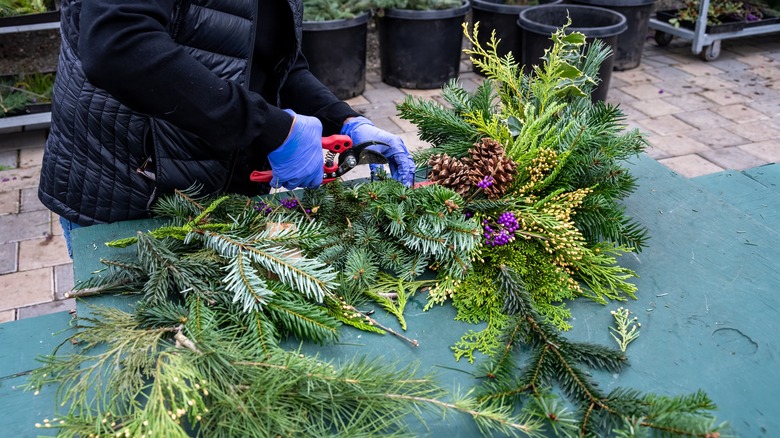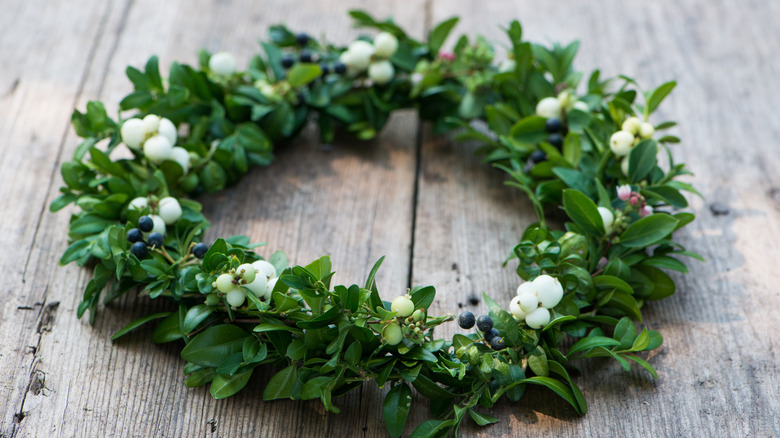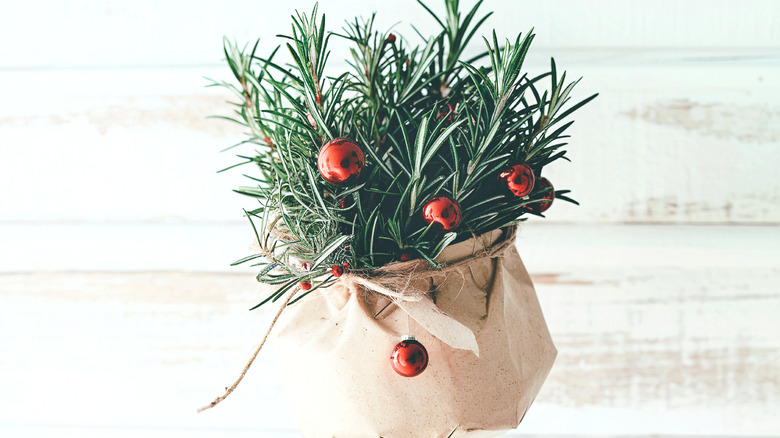8 Evergreen Plants You Can Harvest From Your Own Yard For Stunning Holiday Greenery
'Tis the season to get festive for the holidays. While it's tempting to run out and buy seasonal decor from Home Goods or Dollar Tree to fill your home, the most budget-friendly and accessible source of decor may be right outside your door. Those evergreen trees, bushes, and shrubs in your yard are fantastic sources of holiday cheer, whether you're hoping to make some wreaths or dress up a mantel with a garland. However, some evergreen bushes are better candidates than others for your festive crafts, so pay close attention to determine what will work with your home during this holiday season.
For instance, some usual suspects that often show up in holiday decor scenes, like hemlock or spruce, will drop their needles rather quickly when brought inside, making them messy components to use in your decor. If you live a busy lifestyle and can't be bothered with cleaning and replenishing those cuts consistently, then other choices like holly are likely better suited for your home. Furthermore, other evergreens are more common than others in different parts of the country, so regional options like Southern magnolia (Magnolia grandiflora) can make for more unique holiday-scapes. Depending on your needs and wants, your evergreen yard fixtures can translate beautifully into holiday decor!
Holly
Christmas holly (Ilex aquifolium), also known as common holly, is a quintessential evergreen that's instantly recognizable in festive decor. Hardy in USDA Hardiness Zones 7 to 9, holly's deep green and glossy leaves are perfect for structural seasonal arrangements, while its red berries offer a fun pop of color that matches perfectly with holiday color schemes. Holly is known to be moderately robust, lasting up to two weeks indoors and longer outdoors, so it's an ideal evergreen to grab from your garden for wreaths, mantelpieces, or garlands throughout the holiday season.
Pine or fir boughs
A cornerstone of classic holiday decorations, fresh pine and fir boughs are the perfect evergreen to utilize for your holiday-scapes due to their beautiful texture and characteristic fragrance. Pine boughs' flexibility is perfect to work into wreaths, while fir boughs have great needle retention, ideal for long garlands that run across the mantelpiece. To extend their freshness even longer, keep a water-filled spray bottle on hand to spritz the cuttings throughout the season. Nothing quite says a classic, Ralph Lauren holiday like pine or fir clippings creating a lush background for colorful ornaments and twinkling lights.
Juniper
For a wintery pop of color, clip some of that common juniper (Juniperus communis) for an alternative evergreen to pine or fir in hardiness zones 2 to 6. Its signature feature is its feathery foliage, which provides a delicate texture against more structured and bolder evergreens. Its slightly silvery undertone and characteristic blue berries give it a distinctive, slightly frosted look, and its earthy scent brings a crisp aroma indoors. A great accent for wreaths and garlands or a centerpiece for holiday tables, juniper introduces a rustic charm to your winter displays.
Southern magnolia
While many magnolia varieties are deciduous, Southern magnolia (Magnolia grandiflora) is an evergreen famous for its glossy, oversized leaves and fragrant white flowers. Though the flowers won't be around for the holidays, their waxy leaves are the perfect, regional touch for winter displays. Their large, paddle-shaped form provides a dramatic, elegant accent for arrangements and stands out against more delicate evergreens. Hardy in zones 6 to 10, magnolia leaves bring the perfect low country flair to table displays or even among the branches of your Christmas tree.
Boxwood
Common boxwood (Buxus sempervirens), hardy in zones 5 to 8, is a gorgeous wreath alternative to more common materials like pine, particularly if you want something that feels polished and structured. While a perfect way to dress up your holiday decorations, boxwood wreaths also have a year-round appeal, so once you're done with them for the season, it feels perfectly appropriate to keep them up as everyday decor. To make boxwood last longer, soak your clippings in a tub to let them soak up as much water as possible before use.
Cedar
Cedar, particularly varieties like Eastern red cedar (Juniperus virginiana), is beloved in holiday decor for its fine, scale-like foliage that creates a distinctive texture in whatever displays you put it in. Its branches are quite flexible, and thus more whimsical, homey, and relaxed-looking than structured boxwoods or glossy magnolias. Cedars also have a powerful, woodsy aroma, a scent that rivals that of pine or fir for the crown of quintessential holiday smells. A great addition to window swags, wreaths, garlands, and centerpieces, cedar is both visually pleasing and easy to work with.
Yew
A popular evergreen in holiday decorations, yew (Taxus) is known for its deep emerald color and short, flat, and soft needles that give it a uniform, lush texture. Its mini olive-shaped red arils (often mistaken for berries) give the same festive pop of color that holly does in winter displays, but yew's feathery needles make the entire look a bit softer. As a word of warning, though, yew is poisonous when ingested and should be handled with care; keep it out of children's reach and make sure it's in a place that pets can't nibble on it.
Rosemary
Rosemary (Salvia rosmarinus) is an aromatic herb that, incidentally, doubles as holiday decor given its resemblance to pine. Its deep fragrance also smells a bit pine-like, making it a perfect addition to holiday dining table centerpieces. Often pruned into small, conical Christmas tree shapes (which make great host presents, by the way), rosemary is both whimsical and practical as an edible decoration. Tuck sprigs into napkins to spruce up your holiday table, or DIY a rosemary wreath that both looks and smells amazing. After the holidays, transition your rosemary pieces back into the garden as a renewable resource by propagating the cuttings.








